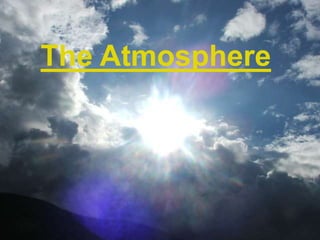
Mauyao, kathlen
- 2. The atmosphere of Earth is a layer of gases surrounding the planet Earth that is retained by Earth’s gravity. The atmosphere protects life on Earth by absorbing ultraviolet solar radiation, warming the surface through heat retention (greenhouse effect), and reducing temperature extremes between day and night.
- 3. Composition of air Air is the name given to atmosphere used in breathing and photosynthesis.
- 4. The Atmosphere ______ The temperature in the atmosphere ______ varies depending on the different ______ layer we are in. ______
- 5. Exosphere Thermosphere Mesosphere Stratosphere Troposphere
- 6. The Troposphere (I) • It is the lowest level of earth’s atmosphere where the right mixture of oxygen and nitrogen works to support life. • Here, living things are also free from the radiation showers which flow down through most of the earth’s atmosphere. • Compared to the rest of the atmosphere, the troposphere is a tiny layer, extending at most 16km up from the earth’s surface. Within this small layer almost all of our weather is created.
- 7. The Troposphere (II) • Generally, as altitude increases, temperature decreases steadily. But the earth's topography—mountain ranges and plateaus—can cause some lower regions in the troposphere to experience temperature inversions. • Towards the top of the troposphere temperatures fall to an average low of - 57 ºC and wind speeds increase significantly, making the top of the troposphere an extremely cold and windy place.
- 8. The Stratosphere (I) • The gradual change from the troposphere to the stratosphere begins at approximately 11km high. The temperature in the lower stratosphere is extremely stable and cold at -57 ºC. • There are strong winds. High cirrus clouds sometimes form in the lower stratosphere, but for the most part there are no significant weather patterns in the stratosphere.
- 9. The Stratosphere (II) • From the middle of the stratosphere and up, the temperature pattern undergoes a sudden change, sharply increasing with height. Much of this temperature change is due to increasing levels of ozone concentration which absorbs ultraviolet radiation. • The temperature can reach 18 ºC in the upper stratosphere near an altitude of 40km high.
- 10. The Mesosphere • 40km above the earth’s surface marks the transition to the mesosphere. In this layer, temperature once again begins to fall as altitude increases, to temperatures as low as -143 ºC near its top, 81km above the earth. • Such extreme cold allows the formation of so-called noctilucent clouds, made of ice crystals clinging to dust particles.
- 11. The Thermosphere • It directly above the mesosphere and directly below the exosphere. Within this layer, ultraviolet radiation causes ionization. • Thermospheric temperatures increase with altitude due to absorption of highly energetic solar radiation by the small amount of residual oxygen still present. Temperatures can rise to 2,000°C. • Radiation causes the scattered air particles in this layer to become charged electrically enabling radio waves to bounce off and be received beyond the horizon.
- 12. The Exosphere • The exosphere is the uppermost layer of the atmosphere. • In the exosphere, an upward travelling molecule moving fast enough to attain escape velocity can escape to space; if it is moving below escape velocity it will be prevented from escaping by gravity.
- 13. The greenhouse effect is a process by which radiation from the surface of the Earth is absorbed by atmospheric gases, and is re-radiated in all directions. Since part of this re-radiation is back towards the surface, energy is transferred to the surface and the lower atmosphere. As a result, the temperature there is higher than it would be if direct heating by solar radiation were the only warming mechanism.
- 14. Earth
- 15. Earth is the third planet from the Sun, and the densest and fifth- largest of the eight planets in the Solar System. It is also the largest of the Solar System's four terrestrial planets. It is sometimes referred to as the world, the Blue Planet, or by its Latin name, Terra.
- 16. Prepared by: Kathlen F.Mauyao BEED III B